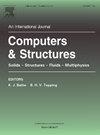Integrated experimental-computational approach for three-stage creep characterization of asphalt mixtures under coupled high temperature-humidity loading
IF 4.8
2区 工程技术
Q1 COMPUTER SCIENCE, INTERDISCIPLINARY APPLICATIONS
引用次数: 0
Abstract
Rutting in asphalt pavements remains a critical challenge for infrastructure resilience under climate extremes. However, the effects of stress levels on the creep behavior of asphalt mixtures subjected to high temperature-humidity conditions have not been fully explored, especially when three-stage deformation occurs. Therefore, this study firstly proposes a five-parameter nonlinear viscoelastic model to characterize the fully-stage of the creep behavior, followed by the identified model parameters via the differential evolution algorithm. Subsequently, a Grünwald-Letnikov fractional calculus-based operator splitting algorithm, implemented via a user-defined material subroutine, achieves computational efficiency while preserving nonlinear fidelity. Finally, the creep test was simulated based on the compiled user material subroutine and finite element modeling. The results indicate that the proposed model can effectively characterize the three-stage deformation characteristics of asphalt mixtures under high temperature-humidity conditions. The Instantaneous elastic modulus under moisture conditions decreased by 27% compared to dry conditions. The proposed finite element implementation algorithm can effectively simulate the creep behavior of asphalt mixtures under different loading and moisture conditions.
高温-湿湿耦合加载下沥青混合料三级蠕变特性的综合实验-计算方法
在极端气候条件下,沥青路面的车辙仍然是基础设施恢复能力的关键挑战。然而,在高温高湿条件下,应力水平对沥青混合料蠕变行为的影响尚未得到充分的研究,特别是在发生三阶段变形时。因此,本研究首先提出了一个五参数非线性粘弹性模型来表征蠕变行为的全阶段,然后通过差分进化算法对模型参数进行识别。随后,通过用户定义的材料子程序实现了基于gr nwald- letnikov分数阶运算符分割算法,在保持非线性保真度的同时实现了计算效率。最后,基于编写的用户材料子程序和有限元建模对蠕变试验进行了模拟。结果表明,该模型能有效表征高温高湿条件下沥青混合料的三阶段变形特征。与干燥条件相比,潮湿条件下的瞬时弹性模量下降了27%。所提出的有限元实现算法可以有效地模拟沥青混合料在不同荷载和水分条件下的蠕变行为。
本文章由计算机程序翻译,如有差异,请以英文原文为准。
求助全文
约1分钟内获得全文
求助全文
来源期刊

Computers & Structures
工程技术-工程:土木
CiteScore
8.80
自引率
6.40%
发文量
122
审稿时长
33 days
期刊介绍:
Computers & Structures publishes advances in the development and use of computational methods for the solution of problems in engineering and the sciences. The range of appropriate contributions is wide, and includes papers on establishing appropriate mathematical models and their numerical solution in all areas of mechanics. The journal also includes articles that present a substantial review of a field in the topics of the journal.
 求助内容:
求助内容: 应助结果提醒方式:
应助结果提醒方式:


